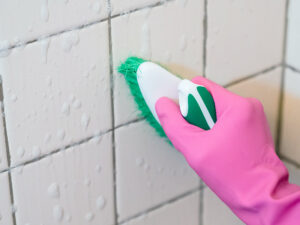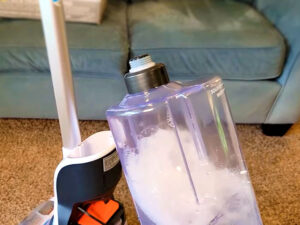As a car enthusiast who pays attention to detail, the sight of mold on leather car seats is distressing. Mold can not only ruin the appearance of your prized car but also cause health problems. But fear not! In the past, I’ve honed in on this problem and am excited to share with you my knowledge in this guide. This comprehensive tutorial will guide you through ten easy and effective ways to remove mold from leather car seats. You can restore the leather seats in your car to their former glory with a few simple tools and techniques. Let’s get started!
10 Easy Steps to Clean Mold off Leather Car Seats
This ultimate guide will show you 10 simple steps to remove mold from leather car seats. From the initial assessment to preventative tips, I’ll provide detailed instructions to restore your leather car seat to its former glory.

Step 1: Initial assessment – Identifying Mold Before cleaning mold from leather car seats, it is important to inspect the seats carefully and determine the extent of mold growth. Look at the entire seat, including the crevices and folds, to assess the extent of the mold infestation. You can then determine the best cleaning method and the materials you need.
Step 2: Safety First – Precautions & Protective Measures Prior to beginning the cleaning process, you must prioritize your own safety by using personal protective equipment. To protect yourself, it is important to wear goggles, gloves, and a mask. Mold spores are harmful when they come in contact with the skin or if you breathe them in. To prevent mold spores from spreading, make sure that the area where you are cleaning is properly ventilated. Last but not least, dispose of moldy materials according to local regulations.
Step 3: Gather your tools and materials – What you’ll Need In order to effectively remove mold from leather car seats, it’s important that you gather all the required items. The essentials include a HEPA-filtered carpet cleaner, a mold remover suitable for leather, soft brushes or cloths for rubbing, clean, damp cloths, dry towels, and a leather conditioner. You should choose leather-safe cleaning products and adhere to the instructions of the manufacturer for application and dilution.
Step 4: Remove Loose Spores of Mold – Prepare the Surface. Before you apply any cleaning solution to the leather, it is important that any loose mold spores are removed. Brush off the mold with a soft bristle broom, taking care not to damage or scratch the leather. This step removes the mold on the surface and prepares the leather for subsequent cleaning.
Step 5: Vacuum thoroughly – Remove Mold and Debris After you have removed the loose mold spores from the seats, vacuum them thoroughly. To remove any mold spores or debris, use a HEPA-filtered cleaner. Pay attention to the creases and crevices in the seats. Mold can hide there.
Step 6: Choose the right mold cleaner – After vacuuming the leather, you can treat it with a mold remover that is specifically designed for leather. Follow the instructions on how to dilute and apply a mold cleaner that’s safe for leather. Use a mold remover that will kill mold spores, prevent their growth and not damage the leather.
Step 7: Scrub gently – Cleaning Leather Surface Use a soft brush or cloth to scrub the leather surface using mold cleaner. Pay special attention to any areas that have visible mold growth. Follow the instructions provided by the manufacturer on how to apply the mold remover and avoid excess moisture that could damage the leather. Work in small sections and use gentle circular motions.
Step 8: Rinse & Dry – Remove Residue After thoroughly cleaning the leather seats using the mold cleaner it is important to remove any residue. To remove mold cleaner residue, dampen a clean towel with water and wipe the leather surface. Use a towel or a dry cloth to dry the leather. To prevent mold, it’s important to remove any moisture from the leather.
Step 9: Protect and Condition – Restoring Leather Once the leather seats have been thoroughly dried, it is time to protect and condition them. Follow the instructions of the manufacturer to apply a leather conditioner. Leather conditioners will restore leather’s moisture balance, make it soft and supple and prevent future mold growth. Apply the conditioner evenly to the leather using a clean, soft cloth. Work it in gently with circular motions.
Step 10: Preventive Tips – Keep Mold at Bay Once you have successfully removed mold from your leather seats, it is important to take precautions to prevent mold from returning. These tips will help you keep your leather car seats mold-free.
- Vacuum and clean your car’s interior regularly, paying special attention to leather seats and crevices.
- Keep your car windows closed during humid or rainy weather to prevent mold growth.
- Reduce excess moisture in your vehicle by using a dehumidifier.
- When cleaning leather seats, avoid using too much water or moisture.
- To prevent moisture build-up, keep your car’s interior well-ventilated.
- Avoid mold growth by removing any spills and stains immediately from your leather seats.
- Use abrasive or harsh cleaners to clean your leather seats. They can cause damage and encourage mold growth.
- Protect your leather seats from the sun, which can cause them to fade and degrade.
How can I tell if my leather car seat has mold?
Mold can grow in areas that are hidden, such as leather car seats. To prevent mold from spreading, it’s vital to inspect your car seat regularly for signs of growth. You can identify mold on leather car seats in several ways:
- Visual Inspection: Inspect your leather seats to check for visible signs of mold. You can look for patches of white, black or green on the leather. Mold often appears as a powdery or fuzzy texture.
- Musty Odor: Mold can emit a musty odor that is quite noticeable. Mold growth can be detected by a musty smell coming from the car seats.
- Discoloration or Stains: Mold can discolor or stain leather surfaces. Mold growth could be the cause of unusual stains or discolorations on car seats.
- Allergic Reactions: Mold Growth on Leather Seats Could Cause Allergic Reactions. If you or any of your passengers have unaccountable allergic reactions, such as sneezing or coughing or even skin irritation, this could be caused by mold spores.
- Deterioration of leather: Over time, mold can cause leather’s condition to deteriorate. Mold growth can cause the leather to deteriorate over time.
You should take immediate action if you suspect that mold is growing on your leather seats to avoid further damage or health risks.
What are the potential health risks of having mold on leather car seats?
Mold on leather seats can be a health risk. Mold is a fungus that releases spores in the air. This can cause allergic reactions and respiratory problems in some people. Mold on the leather car seats can cause health problems.
- Allergic Reactions: Mold spores may cause allergic reactions among susceptible individuals. These symptoms can include sneezing and coughing, nasal congestion, watery eye, throat irritation, skin irritation, and throat irritation. Mold spores can be particularly irritating to people with respiratory problems, like asthma or allergies.
- Respiratory Issues: Inhaling mold can cause respiratory problems, especially in people with respiratory conditions. Mold spores may irritate respiratory tracts and lead to respiratory infections, or worsen existing respiratory conditions.
- Asthma Attacks: Mold can cause asthma attacks, which include symptoms like wheezing and chest tightness. Children, the elderly, and people with compromised immune systems are at a higher risk of developing mold exposure.
- Fungal Infections: Molds can produce toxic substances called mycotoxins that may cause fungal infections. These infections may affect the respiratory system, skin, or eyes and require medical attention.
- Overall Health Impacts: Mold can have a negative impact on your overall health. Mold can cause headaches, fatigue, and other discomforts that can impact daily activities and life quality.
To prevent health problems, it’s vital to deal with mold growth quickly on leather car seats.
How can I remove mold from leather car seats using household products?
It may be tempting, but it is important to be cautious when using household cleaning products to remove mold from leather car seats. Leather is a fragile material and requires special care. Some household cleaning products are not suitable for leather or may not remove mold. Using the wrong cleaning products could cause additional damage to leather car seats.
Some household cleaning products such as ammonia and bleach can be harsh, and abrasive and strip leather of its natural oils, causing the leather to crack, dry out or discolor. These products can be ineffective at removing mold spores and may even spread the mold into the leather.
Use leather-specific cleaning products. These products are pH-balanced and are formulated to clean and protect leather effectively without damaging it. You should look for leather cleaners that have been specifically formulated to remove mold or have anti-fungal qualities.
It’s best to test any cleaning product first on a small area to make sure it doesn’t cause any negative effects. Use the cleaning product according to the instructions and wear gloves or use proper ventilation.
How often should I clean leather car seats?
The frequency with which you clean mold from leather car seats in order to prevent it from coming back is dependent on a number of factors including climate, use of the vehicle, and the level of infestation. It’s recommended that you clean mold from leather car seats immediately after noticing any signs of growth. This will prevent the mold from spreading.
Regular cleaning and maintenance can prevent mold from growing on your leather seats. Here are a few guidelines to follow.
- Regular Cleaning: You should clean your leather seats at least every month, or even more often, depending on how much you use them. Regular cleaning removes dirt, dust and moisture from leather surfaces, which helps prevent mold growth.
- Immediate Action: Take immediate action if you see any mold growth signs on your leather seats. These include a musty smell, visible mold spots, or discoloration.
- Address Moisture: Moisture can be a major factor in mold growth. Take proactive measures to eliminate any moisture sources in your vehicle, including leaks, spills, or excessive humidity. To prevent mold growth, keep your car’s interior well-ventilated and dry.
- Regular Inspection: Inspect your leather seats regularly for signs of mold, particularly in areas prone to moisture, or near spills, like cup holders or windows. As soon as you detect any mold growth, take immediate action.
- Professional Cleaning: Get your leather seats professionally cleaned at least twice a year by a leather cleaning service that is reputable, depending on how often you use them. A professional cleaning will help to deep clean the leather and prevent mold growth.
You can prevent the return of mold by following these guidelines, and taking proactive steps to keep your leather seats clean and drier.
How can I remove mold from leather car seats using water without damaging the leather?
You can clean mold from leather car seats with water, but you should use it sparingly to avoid damaging the leather. Leather is a material that absorbs water. Excessive moisture can cause the leather to become waterlogged and lead to discoloration or warping.
How to safely clean leather car seats with water:
- Use Distilled water: Instead of using tap water which may contain chemicals and minerals that could leave residue or stains on leather surfaces, it’s best to use distilled filtered water.
- Wet a Soft Cloth: Moisten with distilled or filtered water a clean, soft cloth. Make sure the cloth is damp but not wet. Avoid excessive water as it can saturate the leather.
- Blot, don’t rub: Gently wipe the moldy areas with a damp cloth. Avoid rubbing the leather, or spreading the mold spores.
- Dry Thoroughly: To dry leather surfaces thoroughly, immediately use a clean, dry cloth after cleaning the surface with water. Keep the leather dry. Moisture can encourage mold growth.
- Apply Leather Conditioner: After cleaning the leather with water, you should apply a leather conditioner of high quality to replenish its natural oils. For best results, follow the instructions printed on the bottle of conditioner.
- Test on a Small Area: Before you use water or any other cleaning method to clean your leather car seats test them first in a small area.
Water should only be used with care and caution when cleaning leather car seats.
How do I keep mold off my leather car seats?
After cleaning leather seats, it is important to take proactive steps in order to prevent mold from returning. This includes addressing the causes of mold growth as well as maintaining the leather. Here are a few tips on how to prevent mold from returning after cleaning leather car seats.
- Keep your car interior as dry as possible: Mold grows in damp environments so you should keep it that way. Avoid leaving damp items in your vehicle, like towels or clothing, and address spills or leaks immediately. Reduce excess moisture in your car by using moisture-absorbing products such as dehumidifiers or silica gel packs.
- Ventilate your Car: By improving air circulation and decreasing moisture, you can prevent mold growth. Use a ventilation system or a fan to circulate the air in your vehicle, especially when it’s humid or rainy.
- Clean Regularly: Cleaning leather seats regularly can help prevent mold growth by preventing dirt, dust, and moisture accumulation.
- Clean up Spills and Stains Right Away: As soon as you notice any spills on your leather seats, use the appropriate cleaning method to remove them. Do not let spills or stains remain on the leather for a long time. They can become a breeding place for mold.
- Condition the Leather: Leather conditioners replenish the natural oils in the leather to keep it soft and supple. They also help prevent mold growth. After cleaning your leather seats, follow the instructions on the bottle of leather conditioner.
- Avoid Harsh Chemicals: When cleaning leather seats in your car, you should avoid harsh chemicals and abrasive cleaners. These can damage leather or remove its natural oils making it more susceptible to mold growth. Use mild leather-safe cleaning products that are recommended for automotive leather.
- Check Leather Seats for Mold Growth: Inspect your leather seats regularly for signs of mold, such as a musty smell, visible mold spots, or discoloration. As soon as you notice any mold growth, take immediate action to stop it from spreading.
You can reduce the likelihood of mold growing on your leather seats by following these precautions and taking regular care of them.
Final Thoughts
If you take the proper steps to clean and maintain your leather seats, you can prevent mold from growing again. Follow the simple steps in this guide to ensure your car seats stay clean and mold-free for many years. For best results, always remember to prioritize safety. Use appropriate cleaning products and follow the manufacturer’s directions. Regular cleaning and preventative measures will ensure that your leather seats are free of mold and you have a clean, fresh interior.







